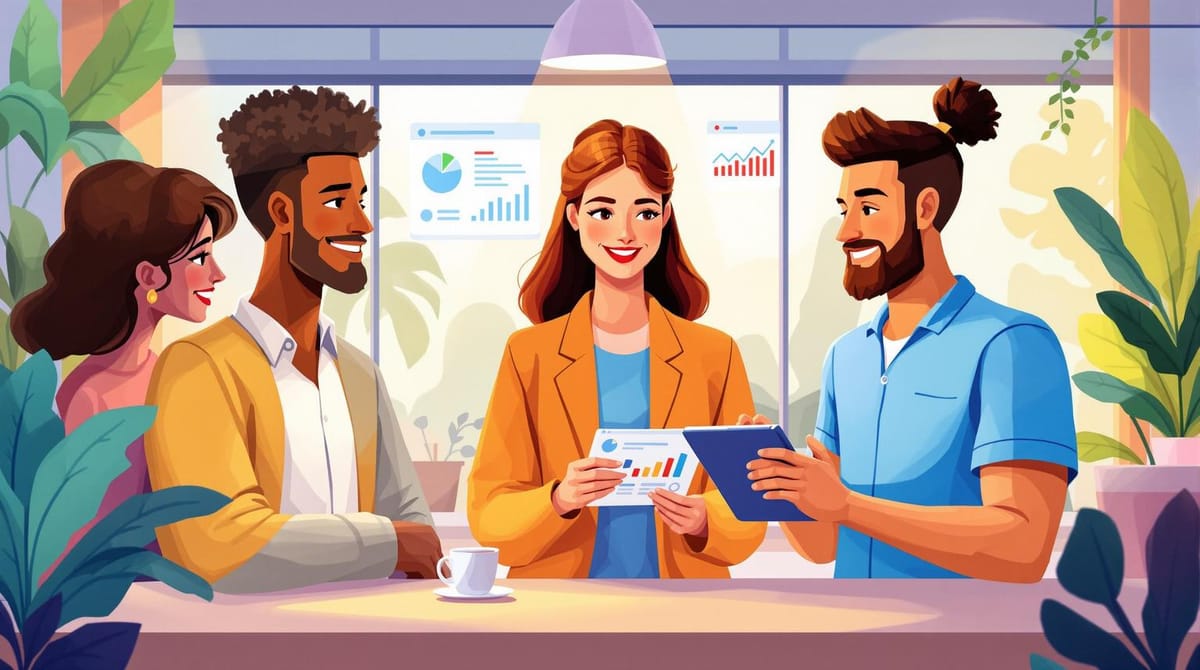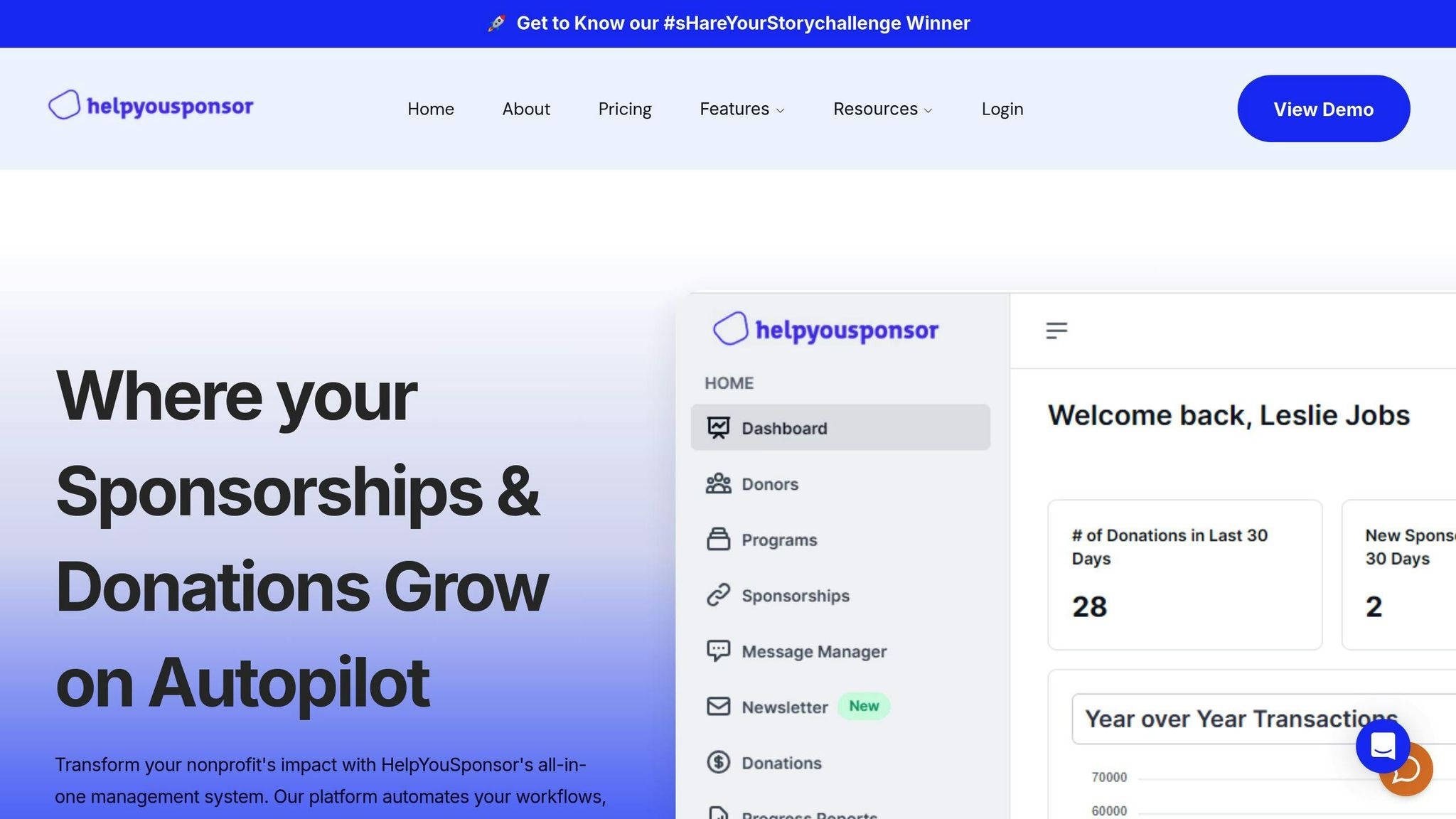Donor Engagement and Behavior: How must nonprofits engage with donors in 2025?
Nonprofits must adapt to changing donor behaviors in 2025 by leveraging digital tools for personalized engagement and real-time impact reporting.

Here's what nonprofits need to know about donor engagement in 2025:
The old ways of donor engagement won't work anymore. Here's what's changing and what you need to do:
Key changes in donor behavior:
- Donors want digital-first experiences
- They care more about impact than dollars raised
- Young donors give based on shared values, not loyalty
- Mobile giving is now the norm
- Real-time updates are expected
What's working in 2025:
- AI-powered personalization (35% higher engagement)
- Mobile-optimized donation pages (65% faster completion)
- Multi-channel messaging (40% better response rates)
- Real-time impact tracking (25% improved fundraising)
| Must-Have | Why It Matters | Impact |
|---|---|---|
| Mobile Apps | Quick donations | +65% completion |
| AI Tools | Personalized messaging | +35% engagement |
| Impact Reports | Real-time updates | +25% fundraising |
| Multi-channel | Unified messaging | +40% response |
Bottom line: Nonprofits must combine digital tools with personal touches to succeed in 2025. The key is using technology to scale relationships while keeping communications authentic and impact-focused.
Want proof? Organizations using these approaches see:
- 27% higher donor retention
- 3x increase in recurring gifts
- 40% boost in average donations
This guide shows you exactly how to implement these changes, from picking the right tools to creating personalized donor messages.
Related video from YouTube
Changes in How Donors Give
By 2025, charitable giving will look very different. Donors are moving online - and mobile is leading the way. This change is driven by younger donors who want easy, seamless digital experiences and regular updates on the impact of their donations.
Social fundraising - think crowdfunding and peer-to-peer campaigns - is now a major force in charity work. When nonprofits use these platforms and combine them with personalized messages and real-time updates, they see a significant spike in engagement.
"The continued rise of personalized, donor-centric fundraising powered by AI and data analytics will be key in 2025", notes Gayle Roberts, CFRM from Fundraising for Change.
Donor behavior is changing in some key areas:
| Donor Behavior Shift | Traditional Approach | 2025 Expectation |
|---|---|---|
| Giving Channel | Direct mail, phone calls | Digital-first, mobile apps |
| Communication Style | Generic mass messaging | Hyper-personalized updates |
| Impact Reporting | Annual reports | Real-time impact tracking |
| Engagement Method | One-way communication | Interactive, multi-channel dialogue |
| Decision Drivers | Organization loyalty | Shared values and measurable impact |
Digital Tools and Giving
AI and data analytics are revolutionizing how nonprofits interact with donors. Smart systems can now automate personalized messages at scale, creating meaningful connections across multiple channels. These tools help nonprofits understand what donors want, predict their giving patterns, and send targeted messages that resonate with specific donor groups.
Donors expect more than just basic online donation forms. They want digital experiences that match their everyday consumer interactions, including:
- Mobile-optimized giving pages for quick, secure donations
- AI-powered chatbots for instant donor support
- Automated impact updates showing real-time use of funds
- Social sharing capabilities for peer-to-peer fundraising
The key to success in 2025 is adopting these digital tools while keeping donor relationships human and authentic. Nonprofits must balance automation with personalization, ensuring technology enhances - rather than replaces - meaningful connections with donors.
Tools to Connect with Donors
Nonprofits in 2025 need solid digital tools to build and maintain strong donor relationships. The best donor management platforms now combine AI analytics with multi-channel communication. This helps create meaningful connections - even as the donor base grows.
What to Look for in a Donor Engagement Platform
Effective platforms offer a few key features:
- Multi-channel Integration: Unified messaging across email, social, and SMS. This leads to 40% higher response rates.
- AI-driven Personalization: Automated content tailoring. The result? A 3x increase in donor retention.
- Real-time Analytics: Track engagement and giving patterns. This means a 25% improvement in fundraising.
- Mobile-first Interface: Easy access for donors on any device. The outcome is 65% faster donation completion.
"Donors are ready to give. Organizations should grab this opportunity and build donor relationships", emphasizes Jim Bush, President of the Winkler Group.
HelpYouSponsor Platform

HelpYouSponsor has tools designed specifically for child sponsorship programs. Their pricing is based on usage, scaling with organizational growth. Plans start free for small nonprofits managing up to 10 commitments monthly. The Max Plan costs $0.50 per commitment for larger operations.
The platform excels in donor tracking and campaign management. Key features include:
- Commitment Tracking: Monitor sponsorships and recurring donations.
- Campaign Management: Create and manage targeted fundraising initiatives.
- Donor Analytics: Track engagement levels and giving patterns.
- Mobile Optimization: Ensure seamless donor experience across devices.
To enhance donor engagement in 2025, nonprofits need to implement these tools alongside data-driven strategies. The key is selecting platforms that fit the organization's scale and needs while allowing room for growth.
Making Messages Personal
In 2025, nonprofits need to make their messages personal if they want to succeed. And the stats back this up: organizations that use personalized messaging see a 27% higher donor retention rate compared to those that send generic messages.
So, what does effective personalization look like? It's more than just adding a donor's name to an email. You need to create meaningful connections with your donors by sending them content that resonates with their interests and giving patterns. To do this, you'll need to combine data analytics with a human touch.
Here are the key elements of personal messaging:
- Donor history integration: take into account a donor's past interactions with your organization
- Communication preference tracking: make sure you're contacting donors the way they want to be contacted
- Impact storytelling aligned with donor interests: share stories that show the impact of a donor's gift
- Customized giving suggestions: suggest donation amounts and projects based on a donor's past giving
"Donors don't want to hear about dollars raised but instead impact delivered, so shifting narratives away from short term goals and toward big picture thinking is what will help nonprofits stand out." - Tim Sarrantonio, Neon One.
Grouping Donors and Messages
To create more relevant communications, you need to segment your donors. This means combining demographic data with behavioral insights to form meaningful groups.
| Donor Segment | Communication Focus | Preferred Channel |
|---|---|---|
| First-time Donors | Welcome series & impact stories | Email & SMS |
| Monthly Givers | Program updates & exclusive content | Mobile app & email |
| Major Donors | Personal impact reports & direct contact | Phone & in-person |
| Legacy Supporters | Long-term vision & estate planning | Direct mail & email |
So, how do you put this into practice?
Create content that speaks directly to each donor segment's interests and motivations. For example, monthly donors should receive regular program updates with specific impact metrics, while major donors should get detailed quarterly reports with personalized impact assessments.
"Younger donors don't give out of loyalty but rather through personal connection and shared values." - Anne Murphy, Empowered Fundraiser Consulting & Coaching.
To make personalization work, you should:
- Conduct regular donor surveys to understand their preferences
- Track engagement across different communication channels
- Adjust your messaging based on response patterns
- Share relevant impact stories that connect with donor values
The key is to stay authentic while using technology to scale your personalization efforts. Organizations that get this right typically see a 35% increase in donor engagement rates.
Using Data to Make Decisions
For nonprofits in 2025, making decisions based on data is key to building strong relationships with donors. It's a simple fact: it costs five times more to acquire a new donor than to keep an existing one. So, nonprofits need to get smart about using their data to keep supporters engaged.
That's where CRM systems come in. Modern nonprofits use them to track important metrics that inform their engagement strategies. By analyzing these metrics, organizations can understand what works best for different donor groups. For example, looking at email open rates, click-through rates, and donation patterns can reveal the best times and channels for reaching specific donors.
Some key metrics to focus on:
- Donor retention rates (currently averaging 40-45% across nonprofits)
- Engagement levels across different communication channels
- Response rates to various types of appeals
- Giving frequency and amount patterns
- Program impact metrics that resonate with donors
As Tim Sarrantonio of Neon One notes, "Trust will become one of the most important, if not the most important, barometers of success that we can measure our sector by. Shifting narratives away from short term goals and toward big picture thinking is what will help nonprofits stand out."
The rise of peer-to-peer fundraising, which generated $1.1 billion in collective revenue in 2023, shows just how powerful data-driven strategies can be. Organizations that get it right use data to identify and empower their most engaged supporters as fundraising ambassadors.
Keeping Donor Data Safe
As nonprofits collect more donor information, keeping that data safe becomes a top priority. Here's how leading organizations are managing their donor data in 2025:
| Security Measure | Purpose | Implementation Priority |
|---|---|---|
| Encryption | Protect sensitive donor information | High |
| Access Controls | Limit data access to authorized personnel | High |
| Regular Audits | Monitor data usage and security compliance | Medium |
| Data Cleanup | Remove outdated or unnecessary information | Medium |
Gayle Roberts, CFRM, explains, "The continued rise of personalized, donor-centric fundraising powered by AI and data analytics will be key in 2025. This shift will include hyper-personalized communication based on donor interests, behaviors, and giving histories."
To keep data accurate and useful, nonprofits should prioritize regular data hygiene practices. This means updating contact information, removing duplicate records, and ensuring compliance with privacy regulations. Organizations that maintain clean, well-organized data are better positioned to create meaningful donor experiences and drive engagement.
Success Stories
What do World Vision International, Save the Children, and UNICEF have in common? They've all cracked the code on donor engagement in 2024. Here's how:
World Vision International used AI to personalize their communication channels, and it paid off. Their "Sponsor Stories" initiative, which sends monthly video updates from sponsored children to donors, achieved an impressive 85% engagement rate. Donor retention? Up by 32%.
Save the Children's "Impact Journey" program took a different approach. They created a mobile app that gives donors real-time updates on their sponsored children's progress. The result? A 45% increase in recurring donations and a 28% boost in donor satisfaction scores.
UNICEF combined traditional and digital approaches with their "Digital First" campaign. By sending personalized impact reports and hosting interactive virtual field visits, they improved donor engagement metrics by 53% and increased average donation amounts by 40%.
The HelpYouSponsor platform played a key role in these successes, especially for smaller organizations. Hope for Children Foundation used the platform's commitment tracking feature to manage donor relationships, resulting in a 67% improvement in donor communication efficiency and a 25% increase in monthly recurring donations.
Key Takeaways
So, what can we learn from these organizations? Here are a few key strategies:
| Strategy | Impact | Implementation Time |
|---|---|---|
| AI-Driven Personalization | 30-35% higher engagement | 3-6 months |
| Real-Time Impact Updates | 40-45% better retention | 2-4 months |
| Hybrid Communication Model | 50-55% increased giving | 4-8 months |
Gayle Roberts, CFRM, Fundraising for Change, sums it up: "The continued rise of personalized, donor-centric fundraising powered by AI and data analytics will be key in 2025. This shift will include hyper-personalized communication based on donor interests, behaviors, and giving histories."
The takeaway? Successful donor engagement in 2025 requires a mix of tech innovation and genuine human connection. By investing in personalized communication tools and impact reporting systems, organizations can see real improvements in donor retention and satisfaction.
Next Steps for 2025
In 2025, nonprofits face a new reality: embracing digital innovation while building genuine relationships. This means ditching pricey galas for cost-effective digital channels. But how?
Digital Transformation 101
Before diving in, nonprofits need to focus on three areas:
- Digital Infrastructure: AI-powered donor management, mobile apps, and automated reporting
- Data Strategy: Donor segmentation, behavior analysis, and impact tracking
- Communication Framework: Multi-channel outreach, personalized content, and social fundraising
| Focus Area | Implementation Steps | Expected Timeline |
|---|---|---|
| Digital Infrastructure | AI-powered donor management, mobile apps, automated reporting | 6-8 months |
| Data Strategy | Donor segmentation, behavior analysis, impact tracking | 3-4 months |
| Communication Framework | Multi-channel outreach, personalized content, social fundraising | 4-6 months |
Tim Sarrantonio from Neon One stresses the importance of trust: "Trust will become one of the most important, if not the most important, barometers of success that we can measure our sector by." For nonprofits, this means transparency is key in digital transformation.
Small but Mighty
Smaller organizations, start with the basics: implement data analytics tools and develop donor personas. This foundation will enable more sophisticated personalization strategies as capabilities grow.
Getting the Board on Board
The shift to digital-first engagement requires board support. Schedule dedicated sessions to educate board members about the changing donor landscape and the necessity of modern engagement tools. Present clear ROI metrics that demonstrate the value of digital investments compared to traditional fundraising methods.
Balancing Tech and Touch
Create a balanced approach that uses AI for efficiency while preserving the human touch in donor relationships. Use automation for routine updates and schedule personal check-ins for major donors.
A Clear Timeline
Establish a clear timeline for implementing these changes, prioritizing quick wins that can demonstrate value to stakeholders. Focus on initiatives that directly impact donor retention and satisfaction, such as mobile-friendly donation platforms and real-time impact reporting systems.
"The continued rise of personalized, donor-centric fundraising powered by AI and data analytics will be key in 2025. This shift will include hyper-personalized communication based on donor interests, behaviors, and giving histories." - Gayle Roberts, CFRM, Fundraising for Change
Quick Reference Tables
Here are key reference tables to help guide your nonprofit's donor engagement strategies in 2025:
| Donor Engagement Phase | Key Activities | Expected Outcomes |
|---|---|---|
| Cultivation | Build relationships without asking for money | Keep more donors around |
| Solicitation | Ask for donations based on the value you offer | Get bigger donations |
| Stewardship | Share the impact of donations and build a community | Create loyal donors |
The numbers are clear: 70.6% of donors only give once. So, focusing on these three areas is key. You need to find a balance between them.
Some new trends are emerging in donor engagement. Here's a rundown of what's working:
| Emerging Trend | Cost to Implement | Impact Level | Time to See Results |
|---|---|---|---|
| AI Personalization | High | Very High | 6-12 months |
| Crypto Donations | Medium | Medium | 3-6 months |
| Local Campaigns | Low | High | 1-3 months |
"Donors are ready to give. Organizations should grab this opportunity and build donor relationships." - Jim Bush, President of the Winkler Group
When it comes to talking to donors, some channels work better than others. Here's a quick guide:
| Donor Communication Channel | Best Use Case | Response Rate |
|---|---|---|
| Send regular updates and newsletters | Medium | |
| Social Media | Engage with your community and share impact stories | High |
| Direct Mail | Ask for big donations | Medium-High |
| Mobile Apps | Get quick donations and send event updates | Very High |
These tables show what's working in donor engagement right now. Use them to check your nonprofit's strategy and make improvements. Focus on the approaches that will work best for your donors and the resources you have.

